Common Ice Cream Questions
How Much Ice Cream a Day: A Guide to Enjoying Your Treat

Have you ever pondered the limit of ice cream consumption before it’s considered too much? Don’t worry, we have all the information you need!
In this article, we explore the recommended daily intake for both children and adults, as well as factors to consider when setting your personal ice cream limit.
We’ll also share some handy portion control tips and suggest healthier alternatives to satisfy your sweet tooth.
So, let’s dive in and discover the perfect balance of ice cream pleasure and health-consciousness!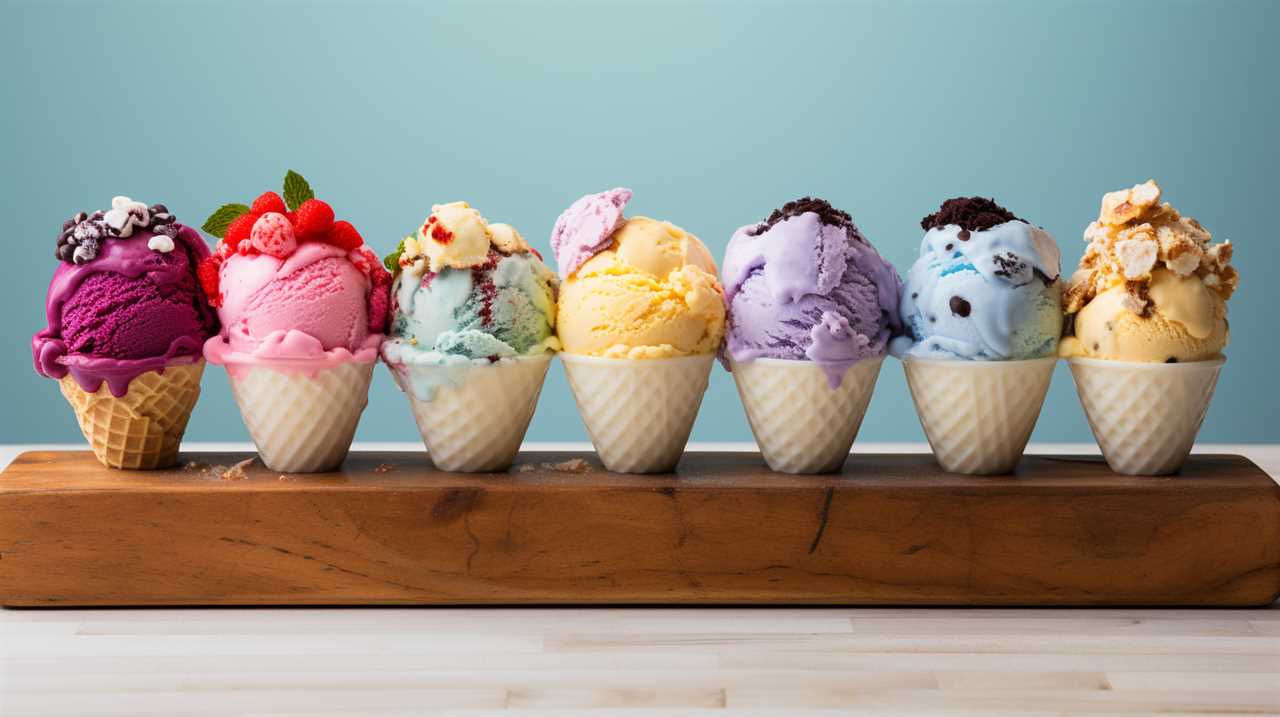
Key Takeaways
- Excessive consumption of ice cream can lead to obesity, dental cavities, high blood sugar levels, weight gain, diabetes, and elevated cholesterol levels.
- Portion sizes play a crucial role in ice cream consumption, and it is important to strike a balance and enjoy it in moderation.
- It is recommended to limit daily intake to a small serving size, choose flavors lower in sugar and fat, and monitor portion sizes for both adults and children.
- There are healthier alternatives to traditional ice cream, such as frozen yogurt, sorbet, gelato, and dairy-free substitutes like coconut milk, almond milk, and soy milk ice cream.
Recommended Daily Intake for Children
We should limit our children’s daily intake of ice cream to a reasonable amount that promotes a healthy lifestyle.
The nutritional value of different ice cream flavors plays a significant role in determining the ideal daily intake for children. Ice cream flavors vary in their composition, with some containing higher amounts of sugar, fat, and calories compared to others.
Excessive ice cream consumption can have adverse effects on children’s health, including increased risk of obesity, dental cavities, and high blood sugar levels. It’s crucial to choose ice cream flavors that are lower in sugar and fat content, and to monitor portion sizes to ensure moderation.
Ice Cream Consumption Guidelines for Adults
To establish healthy ice cream consumption habits, adults should be mindful of their daily intake. Here are four guidelines to help you enjoy ice cream while maintaining a balanced diet:
- Moderation is key: Limit your daily ice cream intake to a small serving size, typically around half a cup. This will help prevent excessive calorie intake.
- Choose wisely: Opt for low-fat or light ice cream options to reduce the amount of saturated fat and calories consumed. Additionally, consider selecting fruit-based flavors or those with lower sugar content.
- Mind your toppings: Be mindful of the additional calories and sugar that toppings such as chocolate syrup, whipped cream, and sprinkles can add to your ice cream. Consider healthier alternatives like fresh fruit or nuts.
- Balance with exercise: Regular physical activity can help offset the potential weight gain from consuming ice cream. Engage in moderate exercise, such as brisk walking or cycling, to maintain a healthy lifestyle.
Factors to Consider for Personal Ice Cream Limit
When determining our personal ice cream limit, there are several factors to consider. One important factor is portion sizes. It’s crucial to be mindful of the amount of ice cream we consume in one sitting. The table below provides recommended portion sizes based on different ice cream types:
| Ice Cream Type | Recommended Portion Size |
|---|---|
| Regular | 1/2 cup |
| Low-fat | 3/4 cup |
| Sugar-free | 1 cup |
Another factor to consider is the effects of excessive ice cream consumption. While indulging in a small amount of ice cream can be a delightful treat, consuming too much can have negative consequences. Excessive intake can lead to weight gain, increased risk of diabetes, and elevated cholesterol levels. It’s important to strike a balance and enjoy ice cream in moderation to maintain a healthy lifestyle.
Ice Cream Portion Control Tips
To maintain a healthy ice cream consumption, it’s important that we practice portion control techniques. Here are four tips to help you control your portion sizes and practice mindful eating:
- Use smaller bowls or cups: By using smaller containers, you can trick your mind into thinking you’re eating more than you actually are. This can help prevent overeating.
- Measure your portions: Use measuring cups or a food scale to accurately portion out your ice cream. This will help you avoid consuming more than the recommended serving size.
- Focus on quality, not quantity: Instead of mindlessly eating a large portion of ice cream, savor a smaller serving of high-quality ice cream. This can satisfy your cravings without consuming excessive calories.
- Slow down and enjoy: Take your time while eating your ice cream. Chew slowly and savor each bite. This can help you feel more satisfied and prevent overeating.
Healthier Alternatives to Traditional Ice Cream
As we continue our exploration of ice cream consumption, let’s delve into the realm of healthier alternatives to traditional ice cream. For those who are conscious of their calorie intake, there are several low-calorie options available that still provide a satisfying frozen treat. Some popular choices include frozen yogurt, which typically contains fewer calories and less fat than traditional ice cream. Another option is sorbet, a dairy-free and fruit-based dessert that is naturally low in calories. Additionally, gelato, with its lower fat content compared to ice cream, is a great alternative. For those who are lactose intolerant or follow a dairy-free diet, there are also many delicious dairy-free substitutes available, such as coconut milk ice cream, almond milk ice cream, and soy milk ice cream. These alternatives provide a creamy texture and a wide variety of flavors without the use of dairy products. To help you make a more informed decision, here is a table comparing the nutritional information of traditional ice cream and some healthier alternatives:
| Ice Cream Type | Calories (per 1/2 cup) | Fat (grams) | Sugar (grams) |
|---|---|---|---|
| Traditional | 250 | 15 | 20 |
| Frozen Yogurt | 120 | 2 | 16 |
| Sorbet | 100 | 0 | 25 |
| Gelato | 180 | 8 | 17 |
| Coconut Milk | 150 | 10 | 15 |
| Almond Milk | 140 | 7 | 14 |
| Soy Milk | 130 | 4 | 16 |
Frequently Asked Questions
Can Ice Cream Be Considered a Nutritious Snack for Children?
Ice cream can be a nutritious snack for children if consumed in moderation. It provides essential nutrients like calcium and protein. However, the impact of ice cream on children’s health depends on the flavors and additives used.
Is It Safe for Adults to Consume Ice Cream on a Daily Basis?
Consuming ice cream daily can have negative effects on adults. The high calorie content in ice cream can contribute to weight gain and increase the risk of chronic diseases. It is important to consume in moderation for overall health.
How Can I Determine My Personal Limit for Ice Cream Consumption?
Determining our personal limits for ice cream consumption is crucial for maintaining good health. By monitoring portion sizes, considering individual health factors, and being mindful of added sugars and calories, we can enjoy ice cream in moderation without negative impacts on our well-being.
What Are Some Tips to Control Ice Cream Portions?
Tips for portion control include using a smaller bowl or cone, measuring the serving size, and opting for healthier toppings. Following an ice cream serving size guide can help us enjoy this treat without overindulging.
What Are Some Healthier Alternatives to Traditional Ice Cream?
Low calorie options and dairy-free alternatives to traditional ice cream are becoming increasingly popular. We’ve discovered healthier alternatives that satisfy our sweet tooth without compromising our health.
– Can I Use Leftover Ice Cream to Make Milkshakes?
Yes, you can use leftover ice cream to make milkshakes. Simply blend the ice cream with milk in a 1:1 ratio to achieve the perfect milkshake recipe ratio. Add any additional flavorings or mix-ins as desired, and enjoy a delicious and creamy treat.
Conclusion
In conclusion, it’s important to be mindful of our daily ice cream intake to maintain a healthy lifestyle. According to recent studies, the average American consumes about 23 pounds of ice cream per year, which equates to roughly 70,000 calories.
This staggering statistic highlights the need for portion control and moderation when indulging in this sweet treat. By making informed choices and opting for healthier alternatives, we can still enjoy the occasional ice cream while prioritizing our overall well-being.
Beyond the realm of flavor and technique, Adriano recognizes the importance of sustainability and conscious consumption. His writing often explores eco-friendly practices within the ice cream industry, highlighting the use of locally sourced ingredients, reducing waste, and supporting ethical production methods.
Common Ice Cream Questions
The Irresistible Allure of Blue Bell Red Velvet Ice Cream
Brace yourself for a blissful blend of red velvet cake and cream cheese icing in Blue Bell's Red Velvet Ice Cream – a taste sensation like no other!

Experience the delight of Red Velvet Ice Cream from Blue Bell! This innovative variation takes the beloved classic to new heights, combining luscious ice cream with chunks of red velvet cake and a cream cheese icing swirl for a perfectly balanced taste. Revel in the rich features such as the crisp bits of red velvet cake and the zesty cream cheese swirls. Its smooth texture and striking flavors ensure each bite is an opulent treat. Give in to your dessert desires with this sumptuous and velvety option, offered in both half gallon and pint sizes. This ice cream’s charm will enchant your palate and leave you yearning for more.
Key Takeaways
- Rich, creamy red velvet ice cream with real cake pieces.
- Tangy cream cheese icing swirl for a delightful contrast.
- Available in convenient half gallon and pint sizes.
- Indulgent blend of flavors and textures for a luxurious treat.
- Perfect balance of velvety texture and bold red velvet cake flavors.
Unique Twist on Classic Flavor
Blue Bell's Red Velvet Cake Ice Cream offers a captivating twist on the timeless classic flavor by infusing it with creamy ice cream, decadent cake pieces, and a tantalizing swirl of cream cheese icing. This enticing Red Velvet Ice Cream from Blue Bell brings together the best of both worlds – the rich, velvety taste of red velvet cake and the coolness of ice cream. The cream cheese icing swirl adds a delightful tangy kick, enhancing the overall sweetness of the dessert.
Blue Bell's Red Velvet Cake Ice Cream is a limited-time treat available in both half gallon and pint sizes, ensuring there's an option for every occasion. Whether you're craving a solo indulgence or planning a gathering with friends, this ice cream has you covered. The blend of flavors and textures in this decadent treat creates a harmonious symphony for your taste buds, making it a must-try for anyone looking to experience the classic red velvet flavor in a new and exciting way.
Decadent Red Velvet Cake Pieces
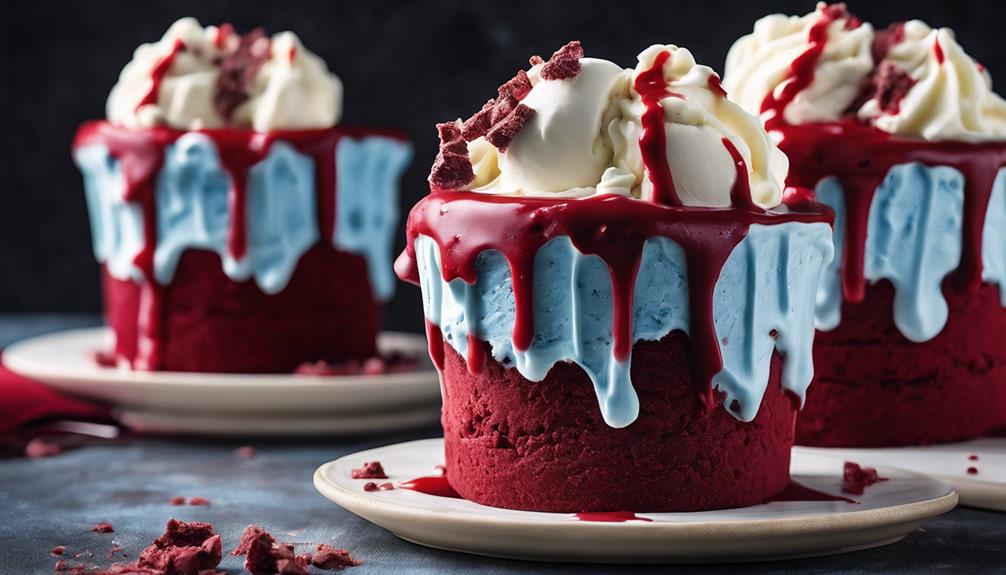
Decadent red velvet cake pieces add a delightful crunch and richness to each spoonful of the Red Velvet Cake Ice Cream. These cake pieces aren't just any ordinary addition; they're the star of the show, elevating the ice cream to a whole new level of decadence. As you scoop into the creamy base of the ice cream, you'll encounter these delectable cake pieces that provide a satisfying contrast in texture and flavor.
The combination of the smooth, creamy base with the indulgent red velvet cake pieces creates an experience that's truly irresistible. Each bite offers a perfect balance between the creamy richness of the ice cream and the cake-like texture of the pieces. It's a symphony of flavors and textures that will leave your taste buds longing for more.
With every scoop of Red Velvet Cake Ice Cream that includes these cake pieces, you're in for a treat that promises a luxurious and indulgent experience like no other.
Creamy Cream Cheese Icing Swirl
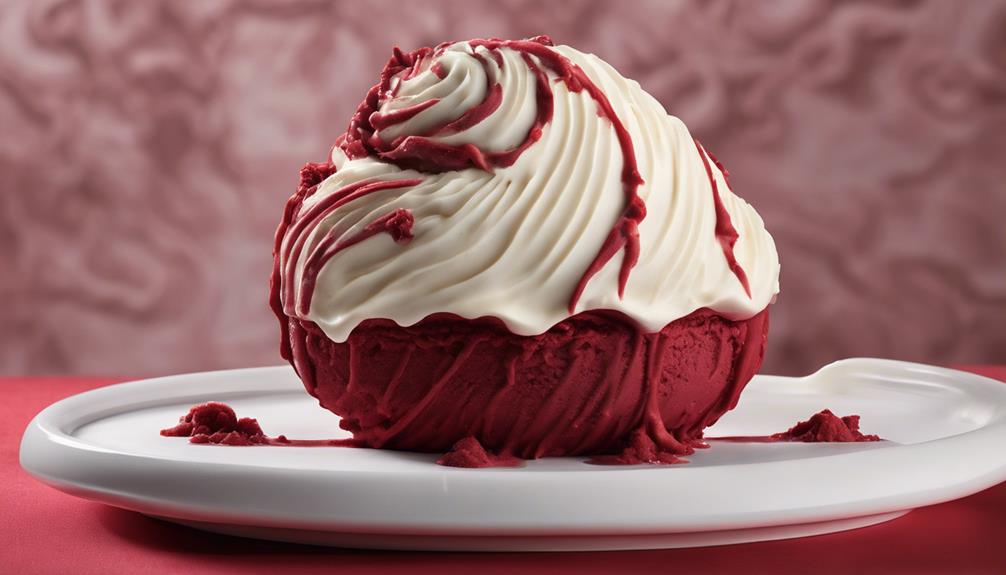
Let's talk about the creamy cream cheese icing swirl in Blue Bell Red Velvet Ice Cream.
This swirl adds a tangy and rich contrast to the sweet red velvet cake flavor.
Each spoonful offers a delightful burst of cream cheese icing, perfectly complementing the creamy texture of the ice cream.
Creamy Swirl Perfection
Enhancing the luscious red velvet cake ice cream is the rich and tangy Creamy Cream Cheese Icing Swirl in Blue Bell Red Velvet Ice Cream. This swirl, made with real cream cheese, adds a decadent and luxurious texture to each spoonful, creating a harmonious blend of flavors and textures. The smooth consistency of the Creamy Cream Cheese Icing Swirl complements the cake pieces, providing a delightful contrast. Fans of cream cheese frosting will savor the authentic and creamy taste that this swirl brings to this limited-time Blue Bell flavor.
| Creamy Cream Cheese Icing Swirl | |
|---|---|
| Real cream cheese | Decadent texture |
| Tangy flavor | Harmonious blend |
Sweet and Tangy
Our taste buds relish the delightful blend of sweetness and tanginess brought by the Creamy Cream Cheese Icing Swirl in Blue Bell Red Velvet Ice Cream. This tangy swirl perfectly complements the rich flavors of the red velvet cake ice cream, creating a harmonious balance that's truly irresistible.
The Creamy Cream Cheese Icing Swirl, with its authentic and decadent taste, enhances the overall flavor profile of this limited-time favorite. Blue Bell's attention to detail in incorporating this swirl guarantees that every scoop is a delicious experience for cream cheese icing enthusiasts.
If you enjoy the tangy goodness of cream cheese icing, you won't be disappointed by the flavorful addition found in every bite of Blue Bell's Red Velvet Ice Cream.
Tempting Flavor Contrast
Indulge in the tantalizing contrast of flavors with the creamy cream cheese icing swirl in Blue Bell Red Velvet Ice Cream. This tempting flavor contrast pairs the tangy cream cheese icing swirl with the luscious red velvet cake ice cream, creating a harmonious blend of sweet and tangy notes.
The rich and decadent cream cheese icing adds a luxurious texture to each bite, enhancing the overall indulgent experience of this beloved flavor. Customers are drawn to the irresistible allure of the cream cheese icing swirl in Blue Bell's Red Velvet Ice Cream, making it a popular choice among dessert lovers.
The delightful tanginess of the cream cheese icing perfectly balances the sweetness of the red velvet cake, offering a truly satisfying treat for your taste buds.
Luxurious and Indulgent Treat
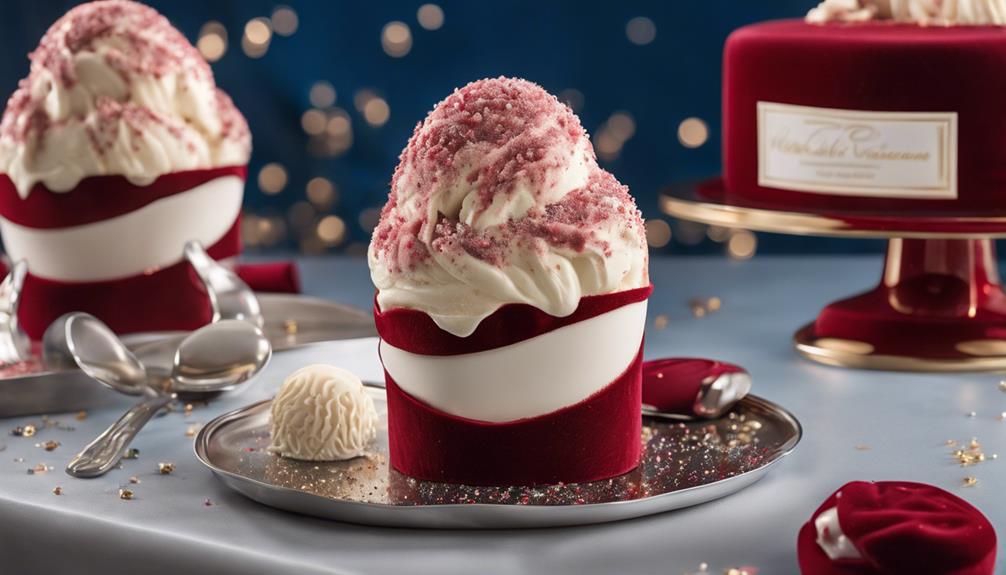
Let's explore the luxurious and indulgent treat that Blue Bell Red Velvet Ice Cream offers.
Indulge in the decadent flavor profile, which includes rich red velvet cake ice cream and cream cheese icing swirls.
The creamy texture of this limited-time flavor promises a delightful dessert experience for all ice cream enthusiasts.
Decadent Flavor Profile
Savor the decadent flavor profile of Blue Bell Red Velvet Ice Cream, featuring luscious red velvet cake ice cream. Indulge in the luxurious combination of red velvet cake pieces and swirls of cream cheese icing. The rich and creamy taste experience of Blue Bell Red Velvet Ice Cream is truly exquisite. Enjoy the irresistible allure of this limited-time treat that captures the essence of red velvet cake. Treat yourself to a luxurious and indulgent dessert with Blue Bell Red Velvet Ice Cream.
- Luxurious red velvet cake ice cream
- Red velvet cake pieces and swirls of cream cheese icing
- Rich and creamy taste experience
- Limited-time treat capturing the essence of red velvet cake
Rich Creamy Texture
The rich and creamy texture of Blue Bell Red Velvet Ice Cream elevates its luxurious and indulgent appeal, promising a delightful treat for the senses.
The creaminess of this ice cream is like a velvety blanket that wraps around your taste buds, providing a smooth and decadent experience.
With each spoonful, you'll discover a perfect balance of cream that melts in your mouth, creating a sensation of pure indulgence.
The cream cheese icing swirls add an extra layer of richness, enhancing the overall texture and flavor profile.
As you savor the creamy texture, you'll also come across delightful red velvet cake pieces that further elevate the experience, making every bite a harmonious blend of cream and cake.
Velvety Texture and Bold Flavors
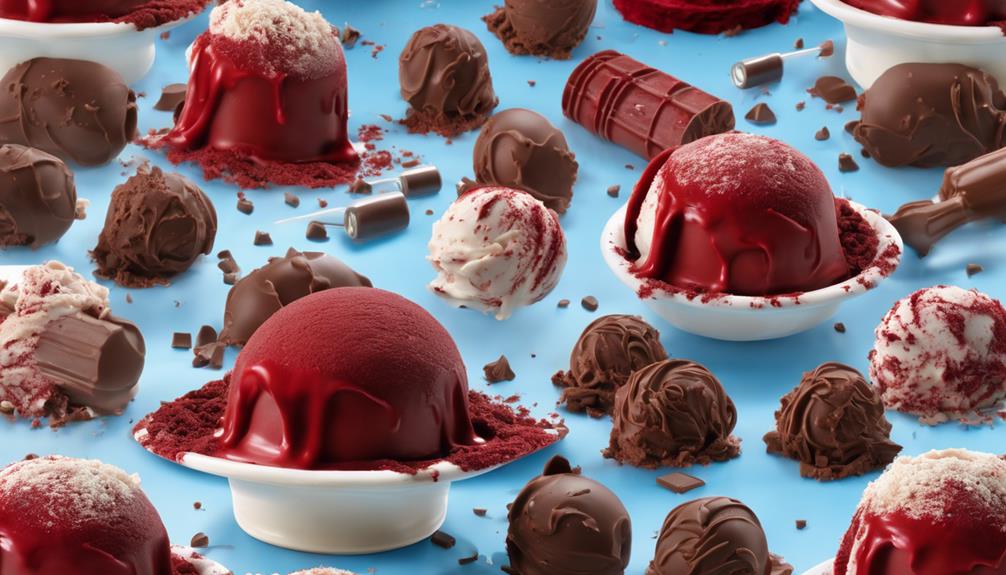
Indulging in Blue Bell Red Velvet Ice Cream, we savor the velvety texture and bold flavors that create a truly decadent experience. The combination of creamy goodness and irresistible taste makes each spoonful a delightful treat.
Here's why the velvety texture and bold flavors of this ice cream stand out:
- Smooth and Luxurious Texture: Blue Bell Red Velvet Ice Cream features a velvety smooth texture that melts in your mouth, providing a rich and creamy sensation with every bite.
- Bold Red Velvet Cake Flavors: The bold flavors of red velvet cake and cream cheese icing swirl together to create a luscious red dessert that tantalizes the taste buds.
- Cake Pieces and Icing Swirl: The creamy texture of the ice cream complements the pieces of red velvet cake and the swirl of cream cheese icing, enhancing the overall decadence of each scoop.
- Satisfying Flavor Profile: Red Velvet Ice Cream is a popular choice among consumers for its luxurious and satisfying flavor profile, making it a must-try dessert option for any sweet tooth.
The velvety texture and bold flavors of Blue Bell Red Velvet Ice Cream offer a truly indulgent experience that you won't want to miss.
Captivate Your Taste Buds
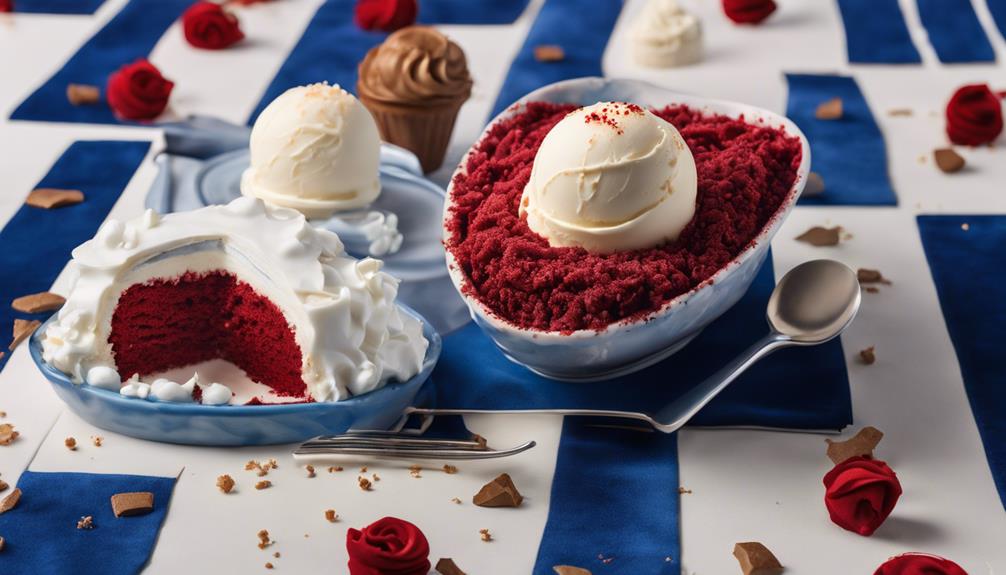
After enjoying the velvety texture and bold flavors of Blue Bell Red Velvet Ice Cream, our taste buds are ready to be captivated by its rich, creamy red velvet cake ice cream. The combination of the decadent red velvet cake ice cream with a swirl of cream cheese icing creates a truly irresistible flavor experience.
As we take each scoop, the red velvet cake pieces scattered throughout the ice cream provide a delightful texture and flavor contrast that keeps us coming back for more. The creamy richness of the ice cream blended with the slight tanginess of the cream cheese icing makes every bite a symphony of flavors that dance on our taste buds.
Whether in the half gallon or pint size, this flavor caters to individual preferences and occasions, ensuring that there's always a perfect amount of this indulgent treat on hand. Fans of Red Velvet Cake Ice Cream find it hard to resist the sweet and velvety allure that captivates their senses with each spoonful.
Satisfy Sweet Cravings
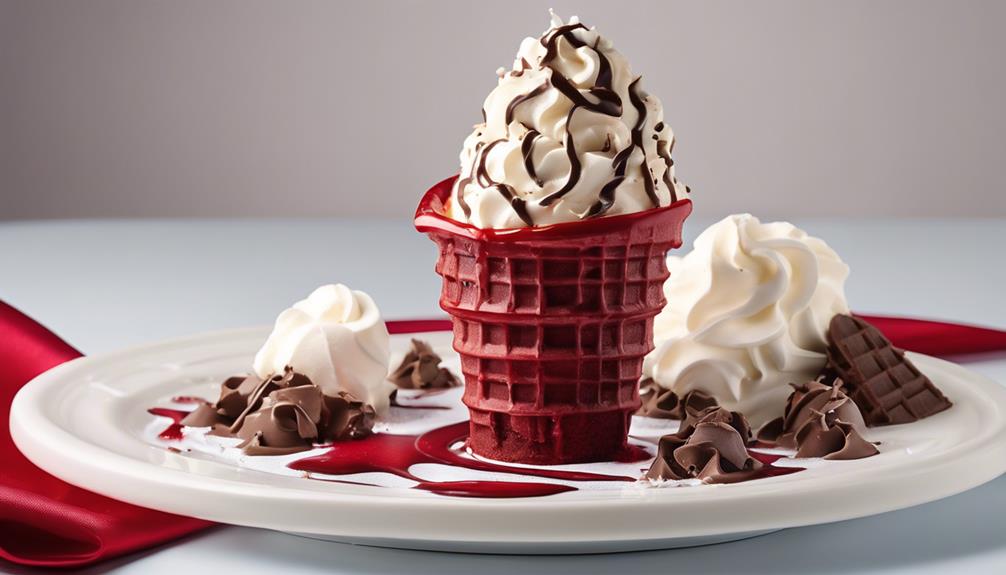
With Blue Bell Red Velvet Ice Cream, succumbing to sweet cravings has never been more deliciously effortless. This delectable treat offers a perfect balance of flavors and textures, making it a go-to dessert for anyone with a sweet tooth. Here's why indulging in Blue Bell Red Velvet Ice Cream will leave you wanting more:
- The rich red velvet cake flavor of the ice cream is truly irresistible, satisfying even the strongest cravings.
- Real pieces of red velvet cake mixed throughout the creamy base provide a delightful contrast in texture and taste.
- Cream cheese icing swirls gracefully complement the red velvet, adding a touch of tanginess and enhancing the overall indulgence.
- Available in convenient half gallon and pint sizes, Blue Bell Red Velvet Ice Cream is perfect for satisfying individual cravings or sharing with friends and family.
Don't resist the temptation to indulge in a scoop of this decadent delight and satisfy your sweet cravings with every spoonful of Blue Bell Red Velvet Ice Cream.
Frequently Asked Questions
Why Did Walmart Stop Selling Blue Bell Ice Cream?
We stopped selling Blue Bell ice cream in 2015 due to a listeria contamination issue. Blue Bell voluntarily recalled all products to address safety concerns.
As part of the recall and safety measures, we temporarily halted sales. Blue Bell then implemented extensive cleaning and safety procedures before returning to the market.
After implementing new safety protocols, Blue Bell ice cream gradually reappeared on store shelves, including ours.
What Is Blue Bell's Number One Selling Ice Cream?
Blue Bell's number one selling ice cream flavor is Red Velvet Cake Ice Cream. It features rich red velvet cake ice cream with cake pieces and a cream cheese icing swirl.
Loved by many for its indulgent taste and creamy texture, this flavor comes in various sizes with nutritional info on the packaging.
Due to high demand, it can often sell out quickly in stores.
What Is the New Bluebell Ice Cream Flavor?
The new Blue Bell ice cream flavor is Red Velvet Cake Ice Cream. It's a delightful mix of red velvet cake ice cream, cake pieces, and a cream cheese icing swirl.
The flavor is available in half-gallon and pint sizes for a limited time. Our local distributor in Lufkin shared samples of this unique flavor, perfect for those who love a tasty blend of sweet and creamy goodness.
Does Blue Bell Make Red Velvet Ice Cream?
Yes, Blue Bell does make Red Velvet Cake Ice Cream. It boasts a delicious blend of red velvet cake ice cream, cake pieces, and a decadent cream cheese icing swirl.
This limited-time flavor has captivated many ice cream lovers with its creamy texture and rich taste. Make sure to grab a half gallon or pint size before it's gone!
Conclusion
To sum up, Blue Bell Red Velvet Ice Cream is a scrumptiously indulgent delight that will fulfill your sugary desires with its distinctive variation on a traditional taste.
The smooth texture, vibrant flavors, and velvety cream cheese icing swirl will enchant your taste buds and have you craving additional servings.
Treat yourself to this lavish dessert and savor the irresistible charm of Red Velvet Ice Cream from Blue Bell.
Mario’s creativity shines through his ability to describe the sensory experience of enjoying ice cream. Whether he’s discussing the velvety texture, the explosion of flavors, or the delightful combinations of toppings and sauces, his words transport readers to a world of mouthwatering sensations. His descriptive language allows readers to imagine and savor the flavors even before taking the first bite.
Common Ice Cream Questions
The Unique Characteristics of Purple Ice Cream Cake Strain
Bold flavors and potent effects await with Purple Ice Cream Cake strain – a must-try hybrid for those seeking something truly special.
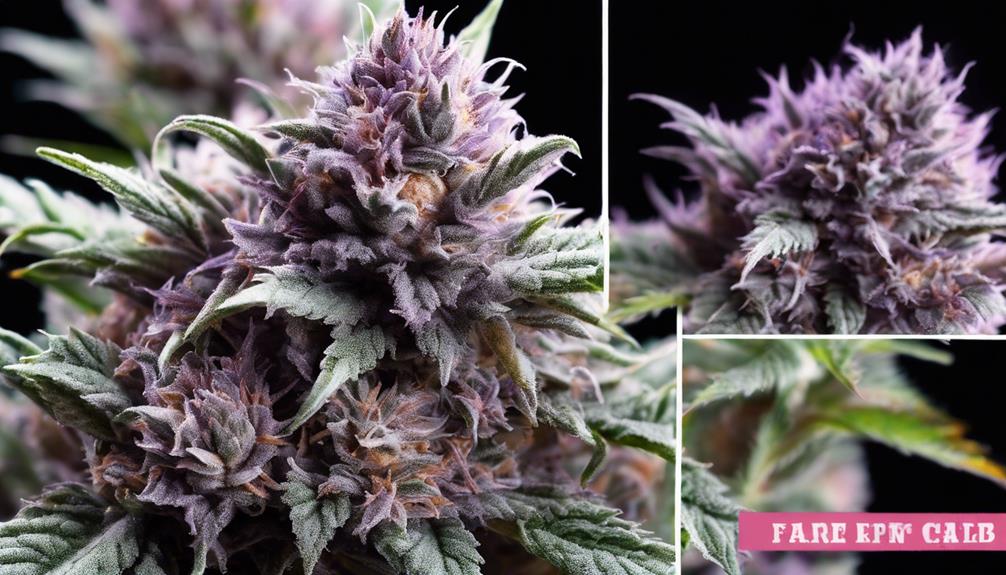
The Purple Ice Cream Cake strain stands out as a primarily Indica hybrid, resulting from the crossbreeding of Purple Ice and Ice Cream Cake strains, and it features THC levels ranging from 25-28%. Its flavor combines notes of cheese, cream, and a hint of sweetness. The aromas encompass citrus, purple fruits, and hints of vanilla. Its effects strike a balance by elevating the mood and providing body relaxation, making it beneficial for dealing with stress, anxiety, and pain. It performs well indoors, especially with the use of topping and ScrOG techniques. Learn more about its unique characteristics to see why it’s favored in the cannabis community.
Key Takeaways
- Genetic composition of 75% Indica and 25% Sativa.
- Aroma of sweet citrus, purple fruits, and creamy vanilla.
- Flavor profile of cheesy creaminess with sweet nuttiness.
- Balanced high combining mood soothing and energizing effects.
- Effective for pain relief, anxiety, stress, and creative focus.
Origins and Genetics
We found that the Purple Ice Cream Cake strain is a hybrid with a genetic composition of 75% Indica and 25% Sativa, resulting from crossing the Purple Ice and Ice Cream Cake varieties. This unique combination gives Purple Ice Cream Cake its distinct effects that cater to a wide range of preferences.
With THC levels ranging from 25-28%, this strain packs a potent punch that can uplift and invigorate. Not only does Purple Ice Cream Cake offer a delightful cheesy, creamy flavor with a hint of sweet nuttiness, but it also provides relief for various medical conditions like depression, chronic pain, insomnia, nausea, and appetite loss.
The genetic makeup of this strain allows for a well-rounded experience that combines the relaxing Indica effects with the uplifting Sativa qualities. Whether you seek relaxation, pain relief, or mood enhancement, Purple Ice Cream Cake's genetic lineage guarantees a comprehensive cannabis experience.
Aroma and Flavor Profile
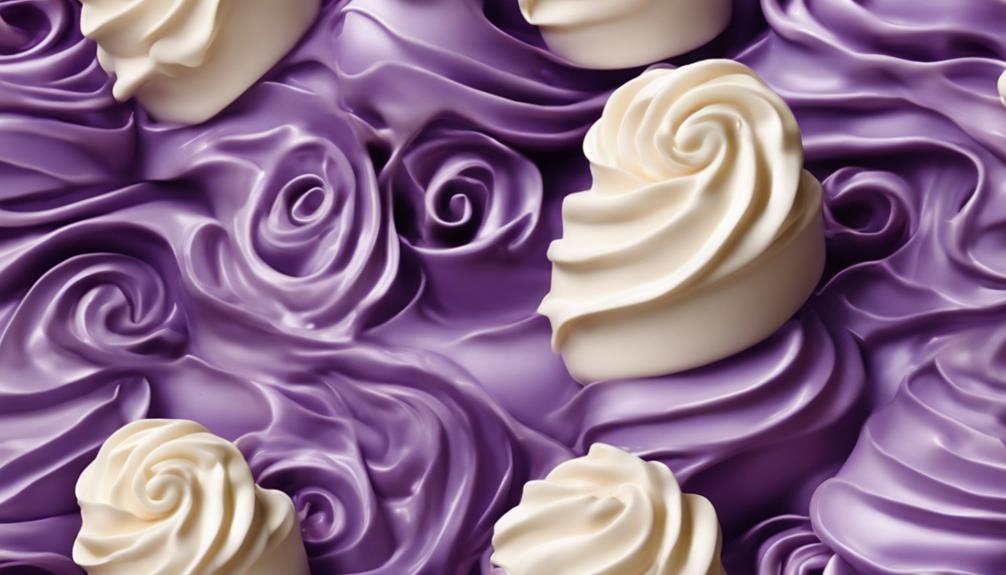
After uncovering the origins and genetics of the Purple Ice Cream Cake strain, the focus now shifts to its alluring Aroma and Flavor Profile. Purple Ice Cream Cake offers a delightful combination of aromas and flavors that make it a favorite among cannabis enthusiasts. The strain's aroma is a mix of sweet and sour citrus, purple fruits, and creamy vanilla notes, creating an inviting scent that draws you in. When it comes to the flavor profile, Purple Ice Cream Cake presents a unique cheesy creamy taste with hints of sweet nuttiness, providing a rich and satisfying taste experience.
Users of Purple Ice Cream Cake can expect to experience a complex blend of flavors that tantalize the taste buds. The strain's creamy vanilla aroma pairs harmoniously with its cheesy creamy taste, offering a balanced and enjoyable cannabis experience. Whether you're a seasoned connoisseur or new to the world of cannabis, the sweet and sour citrus notes combined with the creamy vanilla and cheesy creamy taste of Purple Ice Cream Cake make it a must-try for those seeking a flavorful and aromatic strain.
Effects and Potency
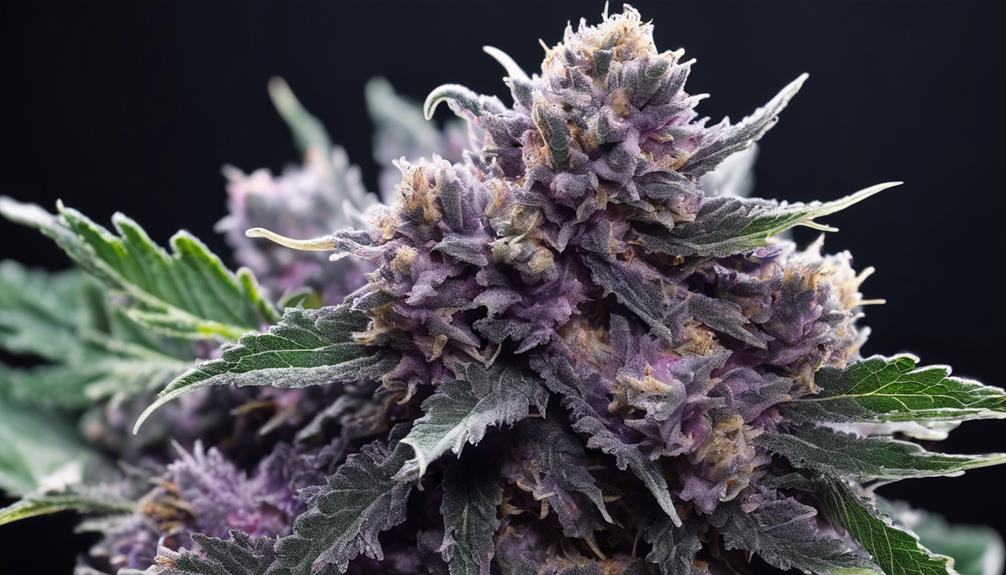
Let's discuss how Purple Ice Cream Cake strain can impact your mood and the strength of the high. Understanding these effects is essential for making informed decisions about consuming this hybrid.
We'll explore how this strain influences your mental state and the level of potency it delivers.
Effects on Mood
What sets the Purple Ice Cream Cake strain apart with regards to its effects on mood and potency?
Purple Ice Cream Cake offers a balanced high, soothing the mood while energizing the mind and body. It enhances creative energy, sparking fits of giggles and a touch of euphoria. With a THC content of 15%, this strain is ideal for those seeking a well-rounded experience. It provides a boost in focus, making it suitable for managing stress, anxiety, depression, migraines, fatigue, and nausea.
Users can expect a harmonious blend of effects that uplift the mood and promote a sense of well-being. Purple Ice Cream Cake stands out for its ability to induce a positive and creative headspace while offering physical relaxation.
Strength of High
Purple Ice Cream Cake strain delivers a balanced high that combines soothing effects on mood with energizing properties for the mind and body. This hybrid strain, with a THC content of 15%, offers a potent experience ideal for managing stress, anxiety, depression, migraines, fatigue, and nausea.
The effects of Purple Ice Cream Cake include boosting creative energy, inducing fits of giggles, and enhancing focus with a touch of euphoria. Its dense spade-shaped nugs with purple undertones emit a delightful aroma of sweet and sour citrus, purple fruits, and creamy vanilla.
Whether seeking relaxation or a burst of creative inspiration, Purple Ice Cream Cake's potency and balanced high make it a versatile choice for those looking to elevate their cannabis experience.
Medical Benefits and Uses
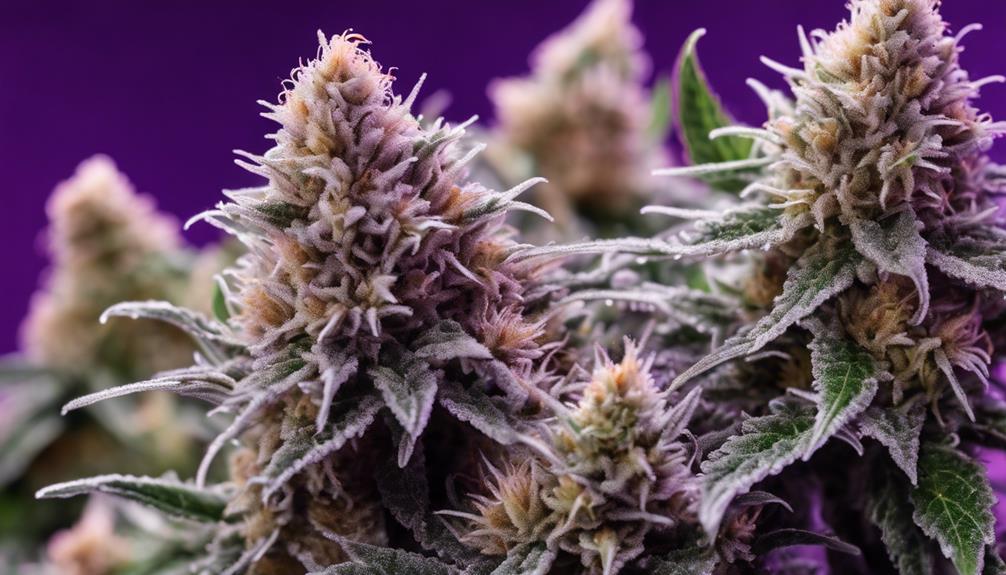
Purple Ice Cream Cake strain offers a range of medical benefits. It can help with pain relief due to its soothing properties.
It also has the ability to ease anxiety and stress, and potentially aid in promoting better sleep.
These characteristics make it a versatile option for individuals seeking relief from various conditions.
Pain Relief Properties
With its high THC content and balanced hybrid nature, the Purple Ice Cream Cake strain offers effective pain relief properties, making it a favored choice among medical marijuana users seeking alleviation from various chronic conditions. This strain's soothing effects can help with muscle aches, headaches, and inflammation, providing relaxation and physical relief. Below is a table highlighting the pain relief properties of Purple Ice Cream Cake:
| Type of Pain | Relief Provided |
|---|---|
| Muscle Aches | Soothing and Relaxing |
| Headaches | Alleviation and Comfort |
| Inflammation | Reduction and Relief |
Purple Ice Cream Cake is known for its medical benefits in managing arthritis pain, back pain, and other chronic conditions. Users appreciate its ability to provide relief without the unwanted side effects of traditional pain medications.
Anxiety and Stress
When managing anxiety and stress, the medical benefits and uses of the Purple Ice Cream Cake strain have been acknowledged by a significant percentage of users. The strain's reported ability to help with anxiety and stress in 20% of individuals who've tried it's remarkable. Here are some key points to keep in mind:
- Purple Ice Cream Cake strain may aid with anxiety.
- It's also observed to provide relief for stress.
- The THC content of 20% in this strain contributes to its potential benefits for anxiety and stress.
- Seeking professional advice before using Purple Ice Cream Cake is recommended for best results.
Sleep Aid Potential
In addressing the potential medical benefits and uses of the Purple Ice Cream Cake strain, its effectiveness as a sleep aid stands out due to its relaxing and calming effects. This cannabis strain, known for its high THC content of 25-28%, delivers a soothing and mellow experience that can help promote a restful night's sleep.
Users have reported that Purple Ice Cream Cake's relaxing body high can aid in combating insomnia by inducing a state of tranquility and drowsiness. Particularly suited for nighttime consumption, this strain's indica-dominant properties make it a promising option for individuals seeking relief from sleep disturbances.
If you're looking for a natural way to unwind and improve your sleep quality, Purple Ice Cream Cake's calming effects may offer the relaxation you need.
Growing Information
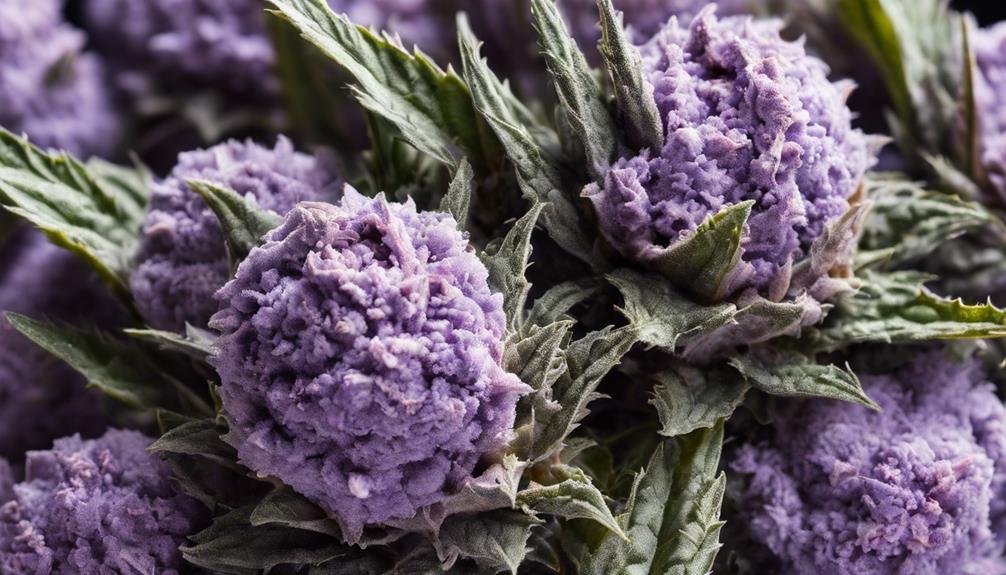
For novice cultivators interested in growing the Purple Ice Cream Cake strain, comprehending key growing information is crucial. Here are some important tips to help you successfully cultivate this strain:
- Select the Right Medium: Opt for coco-coir or cannabis-specific soil blends to provide a favorable environment for your Ice Cream Cake plants.
- Simplify with Pre-Measured Blends: Consider using pre-measured blends to streamline the growing process and guarantee your plants receive the proper nutrients.
- Employ Training Techniques: Implement heavy training methods such as topping and ScrOG net to maximize yields and promote healthy plant growth.
- Indoor Growing Enhancement: When growing indoors, focus on using suitable mediums, pre-measured blends, and training techniques to achieve the best results with your Ice Cream Cake plants.
User Reviews and Recommendations
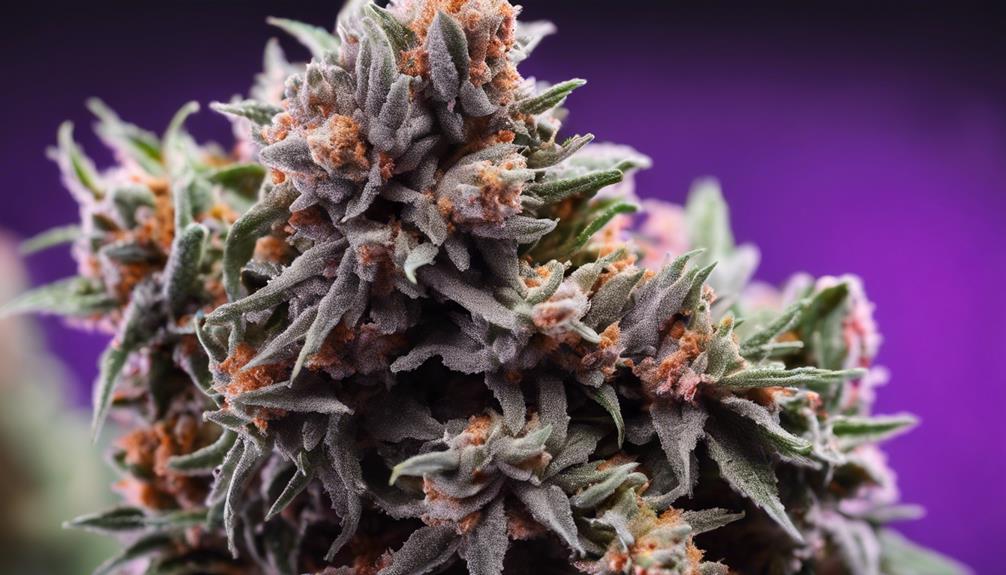
Let's explore what users have to say about the Purple Ice Cream Cake strain and their recommendations. When it comes to user reviews, Purple Ice Cream Cake stands out for its unique flavor profile, described as creamy, cheesy, and sweet with nutty undertones. Users appreciate the delightful taste experience this cannabis strain offers, making it a favorite among those who enjoy flavorful options.
Concerning potency, Purple Ice Cream Cake boasts a high THC level ranging from 25-28%, providing a strong and long-lasting effect that leaves consumers feeling lifted and relaxed.
Furthermore, many users report positive medical benefits associated with Purple Ice Cream Cake, including relief from depression, chronic pain, insomnia, nausea, and appetite loss. This strain's balanced high and creative energy boost make it a versatile option for managing various conditions such as stress, anxiety, depression, migraines, fatigue, and nausea.
Frequently Asked Questions
What Is the Purple Ice Cream Cake Strain?
Purple Ice Cream Cake strain is a popular hybrid with 75% Indica and 25% Sativa. It boasts a delicious blend of cheesy creaminess and sweet nuttiness, offering relaxing effects with a high THC level of 25-28%.
This strain is sought after for helping with depression, chronic pain, insomnia, nausea, and appetite loss. Developed by Seed Junky Genetics, Purple Ice Cream Cake is a favorite in the cannabis community for its potent effects and unique flavor profile.
What Is the Ice Cream Cake Strain Good For?
Ice Cream Cake strain is excellent for managing anxiety, stress, and pain.
It can help us feel relaxed, sleepy, and hungry.
Many users find relief with its vanilla, butter, and sweet flavors.
What Does Purple Strain Do?
When we talk about the effects of the Purple Ice Cream Cake strain, we're looking at a balanced high that uplifts the mind and invigorates the body. This strain is known for boosting creative energy and inducing laughter and focus with a hint of euphoria.
It's often used to treat conditions like stress, anxiety, depression, migraines, fatigue, and nausea. With a THC content of 15%, Purple Ice Cream Cake features dense nugs with sweet and sour citrus, purple fruits, and creamy vanilla aromas.
What Is the Genetic Strain of Ice Cream Cake?
Ice Cream Cake is a balanced hybrid strain with 75% Indica and 25% Sativa genetics. It's a cross between Purple Ice and Ice Cream Cake, showing dense forest green nugs with purple hints and giving off scents of sweet citrus, purple fruits, and creamy vanilla.
The THC content is around 15%. So, when you wonder about the genetic strain of Ice Cream Cake, remember it's a delightful blend of Purple Ice and Ice Cream Cake.
Conclusion
To sum up, the Purple Ice Cream Cake strain offers a unique blend of flavors and effects that make it a popular choice among cannabis enthusiasts. With its origins and genetics traced back to well-known parent strains, this hybrid delivers a potent high with a delicious aroma and taste.
Its medical benefits and ease of cultivation make it a versatile option for those looking for relaxation and relief. Overall, Purple Ice Cream Cake is a standout strain worth trying for its distinctive qualities.
Mario’s creativity shines through his ability to describe the sensory experience of enjoying ice cream. Whether he’s discussing the velvety texture, the explosion of flavors, or the delightful combinations of toppings and sauces, his words transport readers to a world of mouthwatering sensations. His descriptive language allows readers to imagine and savor the flavors even before taking the first bite.
Common Ice Cream Questions
Unique Traits of Ice Cream Haze Strain
Uncover the extraordinary qualities of Ice Cream Haze Strain, a delightful blend of relaxation and energy that will leave you wanting more.
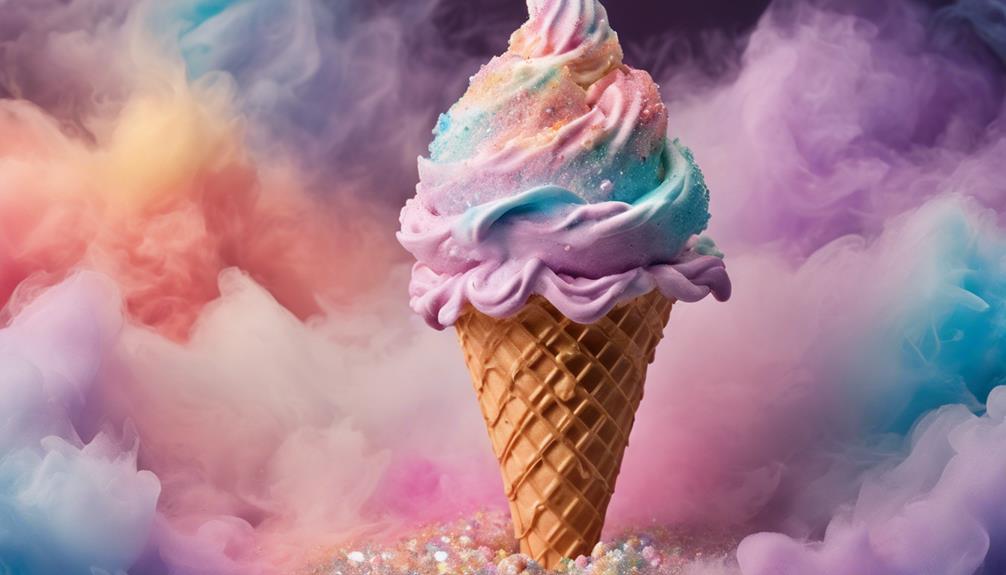
The Ice Cream Haze variety is a hybrid of Ice Cream and Super Silver Haze, masterfully combining serenity with vitality, fostering an environment for both creativity and concentration. This variant is celebrated for its uplifting and pleasant effects, enhancing a sense of happiness. It features a rich, creamy flavor profile with hints of vanilla and sugar, complemented by a silky texture. Its aroma is a delightful mix of vanilla, citrus, and a touch of earthly scents. Ice Cream Haze offers a calming, joyful experience and is beneficial for those dealing with pain, stress, or depressive symptoms. Its distinct terpene composition includes caryophyllene, myrcene, and limonene, known for their healing properties. This strain is also highly productive, particularly in indoor settings, promising a rewarding harvest. Discover its distinctive characteristics!
Key Takeaways
- Blend of Ice Cream and Super Silver Haze for balanced relaxation and energy.
- Promotes creativity, focus, and a joyful, light-hearted experience.
- Exudes a sweet, creamy essence with vanilla and sugar notes.
- Induces relaxation, happiness, and upliftment with THC content of 15-23%.
- Terpene profile includes caryophyllene, myrcene, and limonene for enhanced effects.
Flavor Profile of Ice Cream Haze
Exuding a sweet and creamy essence that evokes notes of vanilla and sugar, the flavor profile of Ice Cream Haze is a delightful sensory experience. This strain, known for its luscious taste, offers a unique combination of flavors that dance on the palate. When you take a puff of Ice Cream Haze, you're greeted with a smooth and velvety texture that hints at the indulgent sweetness of vanilla. The subtle undertones of sugar add a touch of elegance to the overall experience, making it a favorite among connoisseurs.
Additionally, the creamy notes in Ice Cream Haze create a luxurious sensation that lingers on your taste buds, leaving you craving more. The blend of flavors in this strain is carefully curated to provide a harmonious balance between the richness of cream and the sweetness of vanilla. Whether you're a seasoned cannabis enthusiast or a newcomer to the world of strains, Ice Cream Haze is sure to captivate your senses with its delectable flavor profile.
Aroma Characteristics of Ice Cream Haze

With a sweet and creamy essence reminiscent of vanilla and sugar, the aroma characteristics of Ice Cream Haze offer a unique olfactory experience.
The terpene profile of Ice Cream Haze includes caryophyllene, myrcene, and limonene, blending to create a complex aromatic profile. This strain not only exudes sweet vanilla notes but also hints of citrus and earthiness, providing a delightful sensory experience for users.
The combination of these aromas gives Ice Cream Haze a soothing and inviting quality, enhancing the overall cannabis experience. When you encounter the aroma of Ice Cream Haze, you may notice the subtle sweetness intertwined with a touch of citrus, creating a harmonious balance that appeals to the senses.
The terpenes present in Ice Cream Haze contribute to its distinct scent, making it a stand-out option for those seeking a flavorful and aromatic cannabis strain.
Effects of Ice Cream Haze
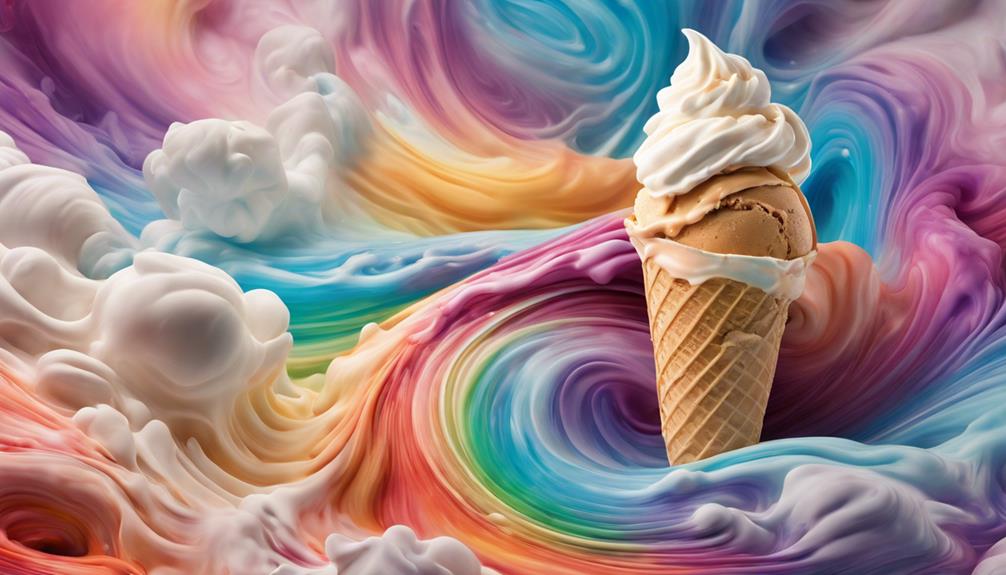
Indulging in Ice Cream Haze brings about a sense of relaxation, happiness, and upliftment. This hybrid strain is celebrated for its ability to provide users with a soothing and blissful experience. With its genetic lineage from White Widow, Bubble Gum, and Californian Skunk, Ice Cream Haze offers a unique combination of effects.
The THC content in Ice Cream Haze ranges from 15-23%, making it a potent option for therapeutic uses such as pain relief, physical discomfort, anxiety, and depression. The uplifting effects of this strain can help elevate mood and promote a sense of well-being.
Users often describe the taste as sweet, creamy, with delightful hints of vanilla and sugar. Whether seeking relief from physical ailments or simply looking to unwind and relax, Ice Cream Haze offers a versatile and enjoyable experience for those who desire a moment of freedom and tranquility.
Unique Terpene Profile of Ice Cream Haze

Ice Cream Haze boasts a unique terpene profile that gives it its distinct aroma and flavor.
These terpenes, like caryophyllene, myrcene, and limonene, play a significant role in the overall experience of consuming Ice Cream Haze.
Understanding these terpenes can help us appreciate the diverse effects and sensory delights this strain has to offer.
Terpene Diversity
Exploring the terpene diversity of Ice Cream Haze reveals a mesmerizing blend of caryophyllene, myrcene, and limonene, each contributing uniquely to its aroma and effects. Caryophyllene offers potential anti-inflammatory and pain-relieving properties, while myrcene may contribute to its relaxing effects, and limonene can provide mood enhancement.
This diverse terpene profile creates a complex flavor profile in Ice Cream Haze, combining sweet, citrusy, and earthy notes. The combination of these terpenes not only influences the taste but also plays a significant role in the overall experience of consuming Ice Cream Haze.
Understanding the terpene diversity in this strain allows for a deeper appreciation of how different elements work together to create its distinctive characteristics.
Aroma and Flavor
After exploring the terpene diversity of Ice Cream Haze, the unique aroma and flavor profile of this strain stand out with its blend of sweet vanilla, citrus, and earthiness.
The sweet aroma of Ice Cream Haze is reminiscent of vanilla with hints of citrus and earthy notes.
Users can expect a creamy taste when consuming this hybrid marijuana, with flavors resembling vanilla and sugar.
The genetic background of Ice Cream strain contributes to its delightful sensory experience, offering a combination of sweet, creamy, and honey-like flavors.
The terpene profile of Ice Cream Haze includes caryophyllene, myrcene, and limonene, enhancing its overall aroma and taste.
Growth Characteristics of Ice Cream Haze
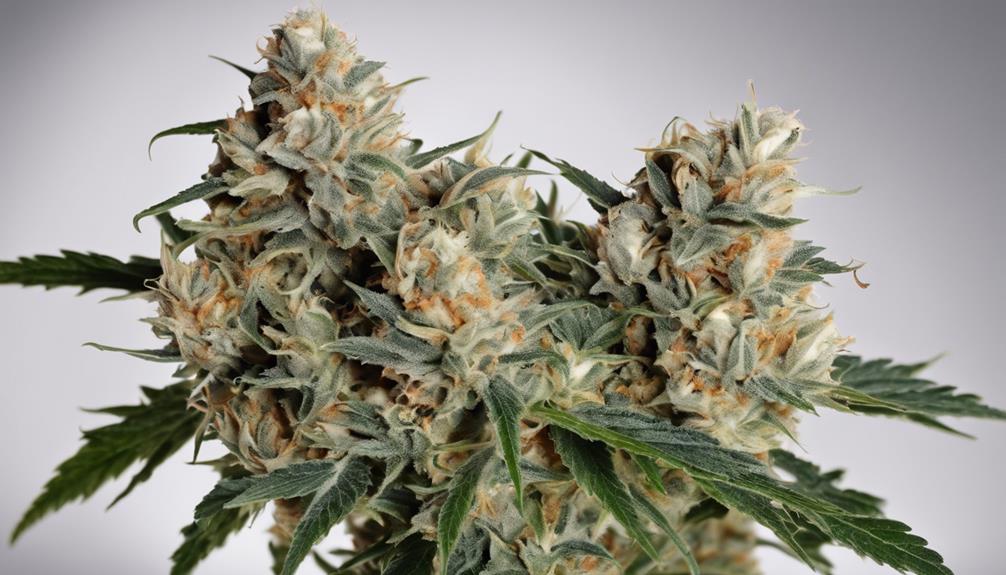
When cultivating Ice Cream Haze, it's crucial to be mindful of its yield potential and flowering time. Understanding these growth characteristics can help us optimize the plant's productivity and overall health.
Yield Potential
With its high yield potential and robust growth characteristics, Ice Cream Haze strain emerges as a top choice for cultivators seeking plentiful harvests of premium buds.
This strain's vigorous growth makes it perfect for indoor cultivation, where it can yield up to 500g/m² of high-quality buds. Its sturdy nature guarantees that it can withstand various growing conditions, making it a dependable option for growers.
Additionally, Ice Cream Haze is relatively easy to grow, making it suitable for beginners looking to start on a rewarding cultivation journey.
Flowering Time
Moving on from discussing the yield potential of Ice Cream Haze, let's now explore its flowering time and growth characteristics.
As an indica-dominant hybrid, Ice Cream Haze boasts a short flowering period of about 8-9 weeks. This quick growth cycle, coupled with its robust growth traits, results in high yields in a relatively brief time frame.
When cultivated indoors, this strain can yield up to 500g/m², showcasing its productivity. Outdoor growers can expect impressive harvests of up to 700g per plant, highlighting the strain's potential for large yields.
Ice Cream Haze's efficient flowering time and bountiful harvests make it a favored choice among both novice and experienced cultivators seeking a rewarding and fruitful cultivation journey.
Medical Benefits of Ice Cream Haze

Ice Cream Haze's medical benefits encompass a range of soothing effects that cater to individuals seeking relief from anxiety, depression, physical discomfort, and insomnia.
- Ice Cream Haze strain offers calming effects with a sweet, creamy taste like vanilla and sugar.
- It's reported to help with anxiety, depression, physical discomfort, and insomnia, providing a soothing and blissful experience.
- The strain contains a high THC content ranging from 15-23%, making it potent for relaxation and mood enhancement.
- Users may experience feelings of relaxation, serenity, happiness, and upliftment when consuming Ice Cream Haze.
When looking for strains with similar effects, Ice Cream Haze stands out for its ability to provide relief and relaxation. However, consulting a health professional before using cannabis for medicinal purposes is crucial to make sure it's the right choice for your needs. Be aware of potential side effects and always seek guidance from a qualified expert to maximize the benefits of this strain.
User Experience With Ice Cream Haze

Our encounter with Ice Cream Haze left us pleasantly surprised by its euphoric and invigorating effects, delivering a sensory experience that tantalized our taste buds with its sweet, creamy notes complemented by hints of citrus and earthiness. This hybrid strain, a blend of Ice Cream and Super Silver Haze, provided a unique high that balanced relaxation with energy.
As we indulged in Ice Cream Haze, we felt a wave of creativity and focus wash over us, making it an ideal companion for activities that require mental clarity and inspiration. The invigorating qualities of this strain made our experience joyful and light-hearted, perfect for moments when we needed a boost of positivity.
Ice Cream Haze stands out not only for its delicious flavor profile but also for its ability to promote a sense of well-being and contentment, making it a favorite among those seeking an euphoric and energizing high.
Comparisons With Other Haze Strains
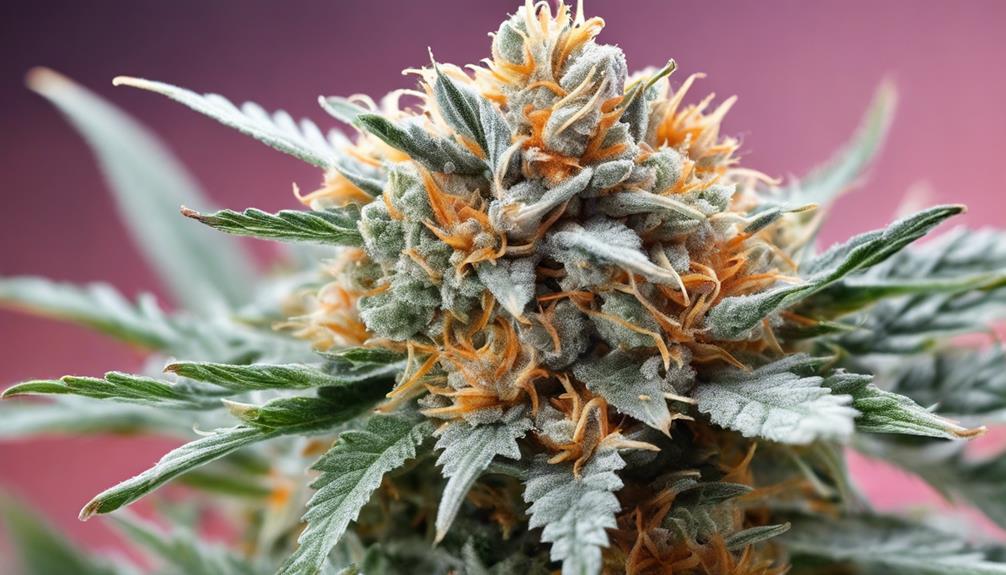
After exploring the user experience with Ice Cream Haze, let's now compare its traits with those of other popular Haze strains. When looking at Ice Cream Haze in comparison to other Haze strains, some notable similarities and differences arise.
- Ice Cream Kush: While Ice Cream Haze offers a sweet, creamy flavor, Ice Cream Kush may have a similar taste profile due to shared genetic lineage.
- Similar Effects to Ice: Ice Cream Haze and other Haze strains like Ice may share relaxing and uplifting effects, providing users with a pleasant experience.
- High THC Content: Ice Cream Haze is known for its high THC content, which can also be a common trait among various Haze strains, leading to potent effects.
- Professional Medical Advice: Before trying Ice Cream Haze or any other Haze strain for medical purposes, it's important to seek professional medical advice to ensure safe and effective usage.
Tips for Enjoying Ice Cream Haze
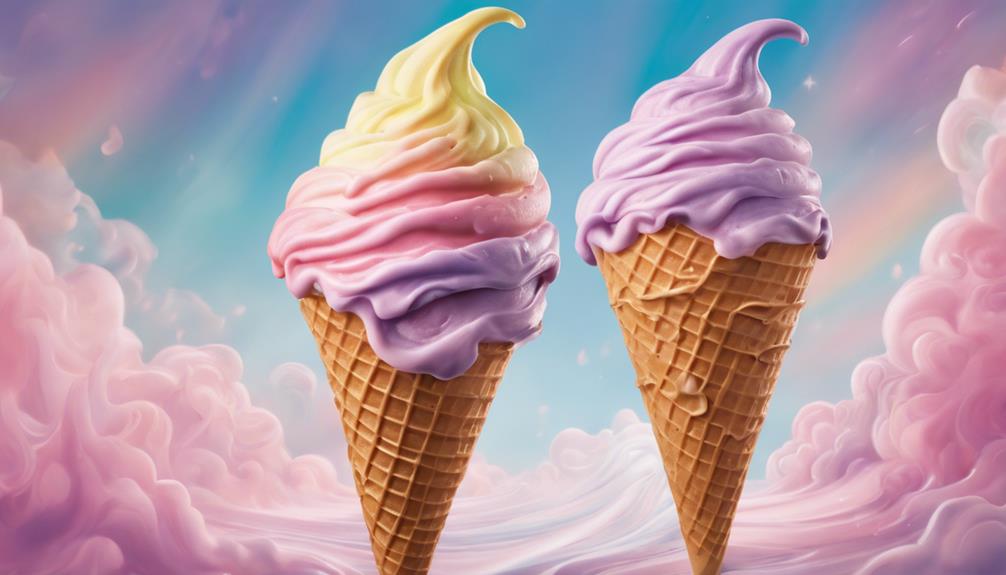
Indulge in the delightful experience of Ice Cream Haze by savoring its unique blend of flavors and effects. When enjoying this hybrid strain, remember to start with a small dose to gauge its potency, as it can offer a powerful euphoric experience.
The sweet and creamy taste with hints of citrus and earthiness is best savored slowly to fully appreciate its complexity. To enhance the therapeutic benefits of Ice Cream Haze, create a calming environment by playing soothing music or lighting candles.
Allow yourself to relax and let the euphoric effects wash over you, promoting feelings of happiness and serenity. Remember to stay hydrated and have some snacks on hand to satisfy any cravings that may arise.
Whether you're seeking a blissful escape or looking for a moment of tranquility, Ice Cream Haze can provide a delightful experience that caters to both recreational and therapeutic needs.
Frequently Asked Questions
How Does Ice Cream Strain Make You Feel?
When we consume Ice Cream strain, we may feel a range of effects, including hunger, arousal, and sleepiness. Users often experience relaxation, serenity, happiness, and upliftment.
However, some individuals may also encounter negative effects like paranoia, dizziness, and dry mouth. The strain's sweet, creamy taste reminiscent of vanilla and sugar enhances the overall experience.
Its calming and soothing properties make it a popular choice for relaxation and mood enhancement.
What Is Ice Cream Haze Strain?
Ice Cream Haze strain is a hybrid of Ice Cream and Super Silver Haze. It combines sweet, creamy flavors with uplifting, energizing effects.
Known for its high THC content, users feel euphoric, creative, and relaxed. This strain offers a unique blend of relaxation and mental stimulation.
It's a popular choice for those seeking a flavorful and potent experience.
What Are the Characteristics of Haze Strain?
When it comes to the characteristics of Haze strain, it's worth noting its reputation for delivering uplifting and euphoric effects. With a high THC content ranging from 18-25%, Haze strains are favored for their energizing and creative properties.
The aroma often features spicy, earthy, and citrusy notes. People commonly turn to Haze strains to combat fatigue, stress, and depression. These traits make it a popular choice among cannabis enthusiasts seeking a mood boost.
What Is the Strongest Strain of Haze?
The strongest strain of Haze is typically considered to be Super Silver Haze. With THC levels ranging from 18-23%, it's known for its uplifting and energizing effects, making it a popular choice among experienced users.
Super Silver Haze, a sativa-dominant hybrid, has won multiple awards and is renowned for inducing creativity, focus, and euphoria. It's a powerful and long-lasting high that can be overwhelming for novice consumers.
Conclusion
To sum up, Ice Cream Haze is a unique strain with a delightful flavor profile, uplifting effects, and a distinct terpene profile. Its growth characteristics make it a favorite among cannabis enthusiasts, and it offers various medical benefits.
When enjoying Ice Cream Haze, take note of its aroma, effects, and terpenes for a truly immersive experience. This strain is sure to leave you feeling refreshed and uplifted, like a cool breeze on a hot summer day.
Mario’s creativity shines through his ability to describe the sensory experience of enjoying ice cream. Whether he’s discussing the velvety texture, the explosion of flavors, or the delightful combinations of toppings and sauces, his words transport readers to a world of mouthwatering sensations. His descriptive language allows readers to imagine and savor the flavors even before taking the first bite.
-
Beginners Guides4 weeks ago
10 Differences Between Ice Cream and Popsicles
-

 Beginners Guides4 weeks ago
Beginners Guides4 weeks agoCreamy Remedies: Good Ice Cream Choices for Acid Reflux Relief
-

 Beginners Guides4 weeks ago
Beginners Guides4 weeks agoHow to Do When Your Ice Cream Tastes Gritty: Quick Fixes
-

 About Ice Cream2 weeks ago
About Ice Cream2 weeks agoWhat Military Diet Rules Allow Ice Cream?
-

 Creative Ice Cream Recipes1 month ago
Creative Ice Cream Recipes1 month agoWho Makes Dairy Queen Ice Cream
-

 About Ice Cream2 weeks ago
About Ice Cream2 weeks ago10 Reasons Why You Feel Like Throwing Up When You Eat Ice Cream
-

 Start your own Ice Cream Shop1 month ago
Start your own Ice Cream Shop1 month agoWhat Makes Ice Cream Salt Essential in the Freezing Process?
-

 About Ice Cream2 weeks ago
About Ice Cream2 weeks agoHow Pouring Milk on Ice Cream Causes Ice Crystals





















